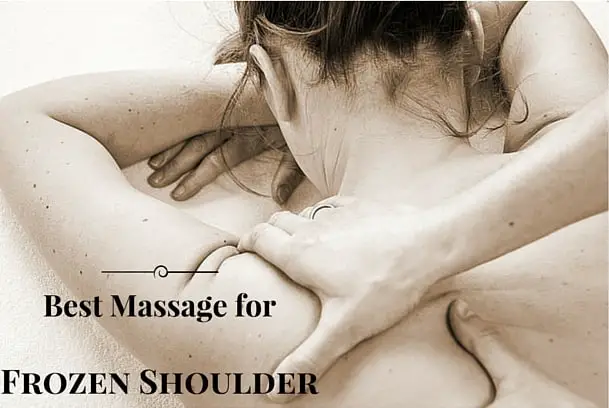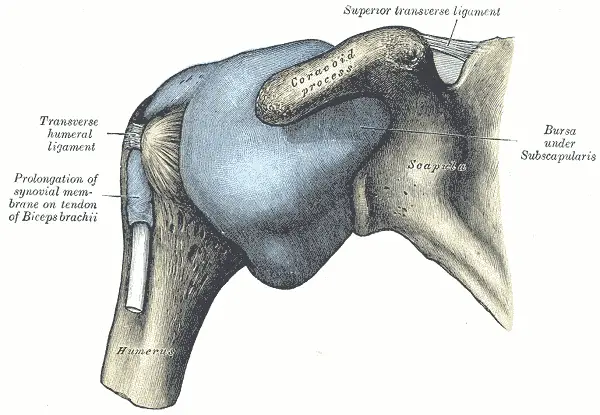Suffering with a frozen shoulder is a very unpleasant and painful experience. Frozen shoulder is a condition that will give the sufferer a great deal of pain and stiffness in their shoulder.
If you have this condition you will not be able to lift your arm to its maximum range. Most people can no longer lift their arm over their head, and simply trying to raise their arm can be incredibly painful.
The medical name for this condition is ‘adhesive capsulitis‘. Although there are some slight differences in what people have come to term ‘frozen shoulder’.
Contents
Treating Frozen Shoulder with Massage
Using massage techniques is one of the most effective ways to start working on frozen shoulder and relieving some of the pain and symptoms. There are various techniques that a therapist will use, the most popular are as follows:
Deep Tissue Massage for Frozen Shoulder
A therapist will often use deep-tissue techniques first to see what progress they can make. This involves applying pressure to the muscles in and around the shoulder to loosen the adhesions, work out the knots and release the scar tissue that may be causing the problem.
One form of deep-tissue massage is a sports massage. Typically used on athletes who have sporting injuries and require deep-tissue work to relieve the pain and repair the damage to the muscles and tissue.
Another is Shiatsu. A technique originating in Japan and involves deep pressure being applied to the areas being worked on. Typically using acupressure points and works on controlling the body’s natural flow of chi.
My advice to you is to seek the advice of a professional therapist and explain your condition in as much detail as possible. They will then be able to advise you of the best form of deep-tissue treatment.
Heat Therapy for Frozen Shoulder
Seeing as the word ‘frozen’ is in the name of the condition, it shouldn’t come as much of a surprise that heat therapy can help. Heat pads or hot towels can be used before and/or after a massage to help relax the muscles.
Heat pads can be used throughout the day as well to help sooth the pain and relax the muscles. A lot of people find this very therapeutic and beneficial not only to their recovery, but to their day-to-day life.
Trigger Point Therapy for Frozen Shoulder
A lot of people have found trigger point therapy to be very effective in helping with frozen shoulder. The techniques in trigger point therapy use a steady flow of pressure on certain points within muscles to target the pain.
This helps stop muscle spasms, delves into the muscle tissue, and gives the sufferer some relief from pain.
Does Swedish Massage Help with Frozen Shoulder
No. Swedish massage is not a form of massage that will help with the symptoms of frozen shoulder. The techniques in Swedish massage are not effective at treating the pain, or working on the muscle groups.
These techniques use long strokes and some gentle kneading and petrissage motions. Not ideal for targeting the muscles in the shoulder.
The Three Stages of Frozen Shoulder Physiotherapy
Physiotherapists look at frozen shoulder as having three different stages. They have developed techniques to deal with each stage, and of course tailor any treatments to meet the individual’s condition.
The three stages are broken down as follows:
Stage One – Freezing
A person in this stage will be experiencing pain around their shoulder. They will notice they are losing some of the range of movement, and find doing everyday tasks becoming more difficult.
This is treated with pain relieving techniques. Such as acupuncture, light massage therapy, and leading on to pain meds and other prescribed treatments if the pain is unbearable.
At this stage it’s important the patient starts to find ways to treat the condition. Leaving it to worsen or aggravating it more makes the condition so much more painful and hard to resolve.
Stage Two – Frozen
This stage is typically where the pain and symptoms have stabilised. Treatment starts to make a difference to the recovery, with range of motion returning and the pain lessening.
The treatments need to be monitored to ensure steady progress is being made. Using massage, physiotherapy, acupuncture and exercises to regain strength, range, and functionality.
It’s important to be patient that this stage. A really good physiotherapist will oversee a treatment plan that pushes just the right amount to avoid doing any further damage.
Stage Three – Thawing
The final stage is hopefully where a patient enters full recovery. It can take some time depending on the individual, but with stretches and physiotherapy the patient should regain full motion and strength in their shoulder.
This stage needs to be managed carefully, but once treatment is compelte the patient should be worry-free about any further complications. Being able to live their live with no shoulder pain, and full, complete movement.

I’m a MA, (CMT) Certified Massage Therapist, Licensed Massage Therapist (LMT), and Reiki Master — I’m a licensed massage therapist with over 10 years of experience in the industry.


